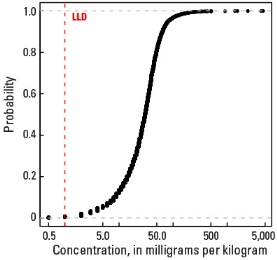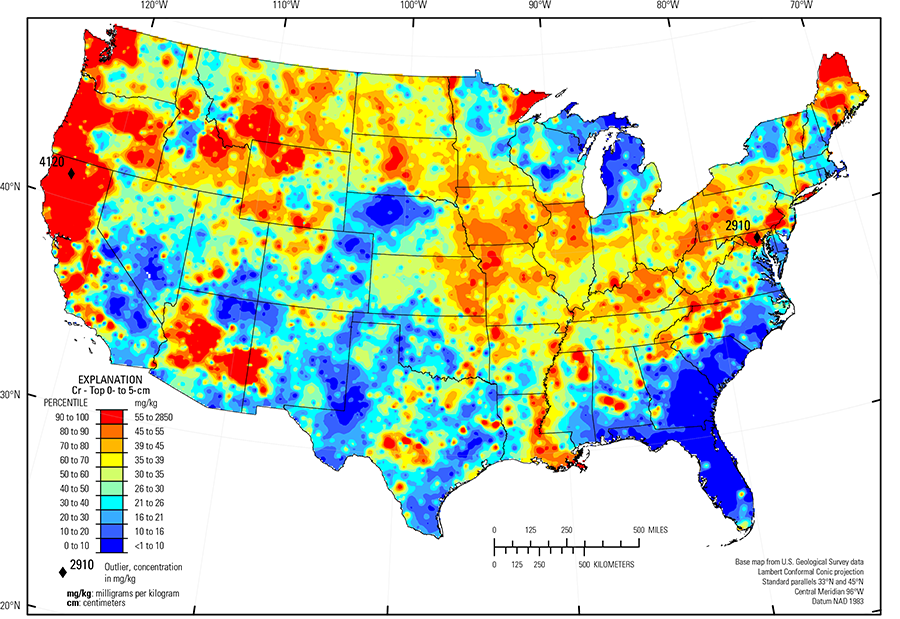
The purpose of these interpretive discussions is to provide a perspective on regional- and national-scale variations in element and mineral distributions in soils and their likely causes. The significant spatial variations shown by most elements and minerals can commonly be attributed to geologic sources in underlying parent materials, but other spatial variations seem clearly related to additional factors such as climate, the age of soils, transported source material, and anthropogenic influences. We attempt to distinguish the influence of these various factors on a regional and national scale. Numerous more local features might similarly be related to these same factors, but these features also have some probability of being an artifact of a random sampling of variable compositions, so that there is some probability of samples with similar compositions occurring in clusters of two or more adjacent sites by chance. Distinguishing such random occurrences from true variability is beyond the scope of the data from which these maps are constructed. Some caution, therefore, is advisable in interpreting the significance of these more local features unless some unique sources or processes can clearly be related to them.
Chromium (Cr) is a metallic trace element used extensively in the production of stainless steel and nonferrous alloys. It is also used in the production of paints and pigments, leather processing, and electroplating. Chromium occurs in the environment primarily in two oxidation states. Chromium(III), the dominant form of Cr in soils, is essential to humans in that it promotes normal metabolism of proteins, fats, and glucose. Chromium(VI), on the other hand, is a known carcinogen and is considered highly toxic. More information about the toxicity of Cr and its potential negative human health impacts can be found at the Agency for Toxic Substances and Disease Registry (ATSDR) website, or click to download a fact sheet about Cr), or at the Environmental Protection Agency (EPA) website (click to download the EPA fact sheet about Cr). It should be noted that the analytical methods used in the current study of soils of the conterminous United States determined total soil Cr, which includes both Cr(III) and Cr(VI).
The most important Cr mineral is chromite ((Fe,Mg)(Cr,Al)2O4), although Cr can occur in other minerals such as pyroxene, amphibole, mica, garnet, and spinel; Cr(III) is readily adsorbed onto iron (Fe) oxyhydroxides and clays in soils. Historically, chromite has been the only Cr ore mineral. Recently, however, recycled Cr ferroalloys have replaced chromite ore as the leading source of Cr for U.S. industry.
The average abundance of Cr in the upper continental crust is estimated to be about 73 milligrams per kilogram (mg/kg) (Hu and Gao, 2008). Ultramafic rocks, such as serpentinite and peridotite, have highly elevated concentrations of Cr with as much as a few thousand mg/kg. Mafic rocks, such as basalt, have an average Cr concentration of about 90 mg/kg. Among the other common rock types, shale has Cr concentrations ranging from 20 to 120 mg/kg. The average Cr concentration of sandstone reported in the geologic literature ranges from 0.3 to 35 mg/kg, the reported average for limestone ranges from 0.1 to 10 mg/kg, and the reported average for granite ranges from 4 to 10 mg/kg.
The distribution of mineral resource deposits with Cr as a commodity (major or minor) in the United States, extracted from the U.S. Geological Survey (USGS) Mineral Resource Data System (MRDS) website, can be seen by hovering the mouse here. Statistics and information on the worldwide supply of, demand for, and flow of Cr–bearing materials are available through the USGS National Minerals Information Center (NMIC) website.
In our data, there is little variation in the median Cr concentration with depth in the soil profile. The median Cr concentration is 30 mg/kg for the top 0- to 5-cm layer and the soil C horizon, and 31 mg/kg for the soil A horizon (see the summary statistics [open in new window]). As a result, the geochemical maps for the three sample types show very similar patterns.
The distribution of Cr in soils of the conterminous United States is primarily controlled by the composition of underlying soil parent materials. Areas of elevated Cr concentrations are seen in:
- Northern California, Oregon, western Washington, extreme southeastern Pennsylvania, central Maryland, central and western North Carolina, northeastern Minnesota, and central Arizona, where the parent materials for soils are, at least in part, ultramafic or mafic rocks or glacial deposits derived from these rock types;
- Parts of eastern Montana, North Dakota, South Dakota, Iowa, eastern Nebraska, eastern Kansas, northern Missouri, Illinois, Indiana, Kentucky, Ohio, and Pennsylvania, where parent materials are dominantly shale, clayey till or glacial deposits containing a significant amount of shale; and
- Southern Blue Ridge, the Southern Piedmont, and the Northern Piedmont (USDA, 2006), where soil parent materials are composed, in part, of igneous and metamorphic rocks of mafic composition (for example, basalt and amphibolite)
The Gulf and Atlantic Coastal Plain (Fenneman and Johnson, 1946) is bisected by the Southern Mississippi River Alluvium and the Southern Mississippi Valley Loess(USDA, 2006) Alluvial sediments have deposited in the Mississippi River valley as the river flooded in recent geologic time. When these sediments dried, winds picked up the fine material and deposited it in thick loess sheets, mainly along the east side of the river valley. The youngest loess sheets are about 10,000 years old. A pattern of higher Cr concentrations in soils developed on these young sediments reflects long–range transport of Cr–bearing material from the upper part of the Mississippi River drainage basin.
Areas of low Cr concentrations in soils include:
- Atlantic Coastal Plain (Fenneman and Johnson, 1946), where parent materials are dominantly quartz–rich sedimentary rocks and unconsolidated sediments;
- Nebraska Sand Hills (USDA, 2006), where parent materials are quartz– and plagioclase–rich, unconsolidated sand dunes and sand sheets;
- Southern High Plains (USDA, 2006) of Texas and New Mexico, where parent materials consist of quartz–rich eolian sands and alluvial sediments; and
- Northern and western Michigan, where parent materials are comprised of quartz–rich glacial deposits.
Statistics - 0 TO 5 CM
| Number of samples | 4,841 |
| LLD | 1 mg/kg |
| Number below LLD | 6 |
| Minimum | <1 mg/kg |
| 5 percentile | 6 mg/kg |
| 25 percentile | 18 mg/kg |
| 50 percentile | 30 mg/kg |
| 75 percentile | 41 mg/kg |
| 95 percentile | 73 mg/kg |
| Maximum | 4,120 mg/kg |
| MAD | 17.8 mg/kg |
| Robust CV | 59.3% |
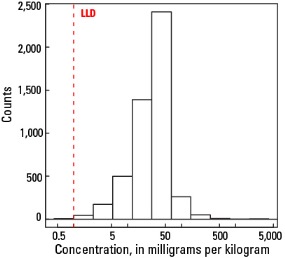
Histogram
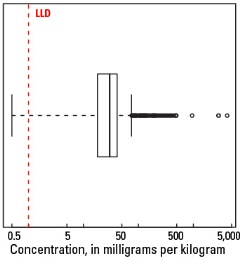
Boxplot
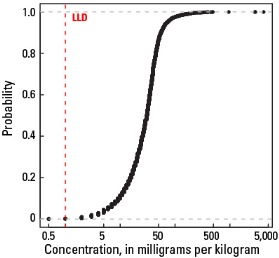
Empirical cumulative distribution function
Statistics - A Horizon
| Number of samples | 4,813 |
| LLD | 1 mg/kg |
| Number below LLD | 12 |
| Minimum | <1 mg/kg |
| 5 percentile | 5 mg/kg |
| 25 percentile | 18 mg/kg |
| 50 percentile | 31 mg/kg |
| 75 percentile | 42 mg/kg |
| 95 percentile | 74 mg/kg |
| Maximum | 3,850 mg/kg |
| MAD | 17.8 mg/kg |
| Robust CV | 57.4 % |
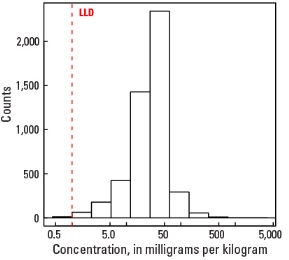
Histogram
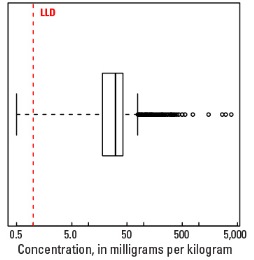
Boxplot
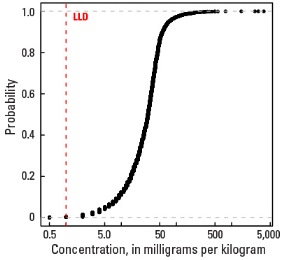
Empirical cumulative distribution function
Statistics - C Horizon
| Number of samples | 4,780 |
| LLD | 1 mg/kg |
| Number below LLD | 19 |
| Minimum | <1 mg/kg |
| 5 percentile | 5 mg/kg |
| 25 percentile | 17 mg/kg |
| 50 percentile | 30 mg/kg |
| 75 percentile | 45 mg/kg |
| 95 percentile | 81 mg/kg |
| Maximum | 4,620 mg/kg |
| MAD | 20.8 mg/kg |
| Robust CV | 69.5 % |
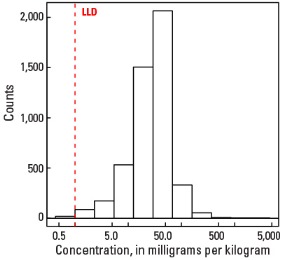
Histogram
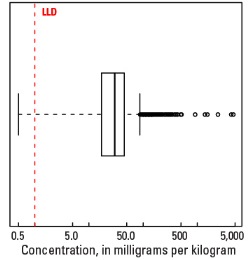
Boxplot
